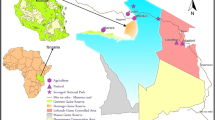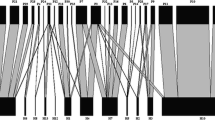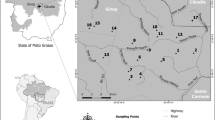Abstract
This paper presents comparative assessment of the timing of host abandonment by different taxa of ectoparasites of small mammals after the host has been captured in a regular snap trap. The data were obtained using a specially designed trap line with automatic logging of the capture time. Our results generally support the basic rule that ectoparasites eventually abandon the dead host. The most tangible and rapid reduction in infection rates following host death was observed in Ixodes persulcatus. Fleas and parasitic gamasid mites abandoned the host in 2–4 h, and lice, in 9–13 h after snap-trapping. Ixodes trianguliceps displayed no sharp decline in abundance for a prolonged period of time.



Similar content being viewed by others
REFERENCES
Balashov, Yu.S., Parazitizm kleshchei i nasekomykh na nazemnykh pozvonochnykh (Parasitism of Acarines and Insects on Terrestrial Vertebrates), St. Petersburg: Nauka, 2009.
Bespyatova, L.A. and Bugmyrin, S.V., Species diversity of gamasid mites (Parasitiformes, Gamasina) on small mammals from the middle taiga of Karelia, Acarina, 2006, vol. 14, no. 2, p. 209.
Bespyatova, L.A. and Bugmyrin, S.V., Iksodovye kleshchi Karelii (rasprostranenie, ekologiya, kleshchevye infektsii) (Ixodid Ticks of Karelia: Distribution, Ecology, and Tick-Borne Infections), Petrozavodsk, 2012.
Bespyatova, L.A., Bugmyrin, S.V., Kutenkov, S.A., and Nikonorova, I.A., The abundance of ixodid ticks (Acari: Ixodidae) on small mammals in forest biotopes of the middle taiga subzone of Karelia, Entomol. Rev., 2021, vol. 101, no. 2, p. 273.
Borisova, V.I., Nazarova, I.V., and Orekhov, E.M., The significance of rodent capture techniques in quantitative studies of ectoparasites and nidicoles, in Nazemnye i vodnye ekosistemy: Sbornik nauchnykh trudov (Terrestrial and Aquatic Ecosystems: Collected Papers), Petrov, V.S., Ed., Gorky, 1982, p. 112.
Bregetova, N.G., Gamazovye kleshchi (Gamasoidea). Opredeliteli po faune SSSR, izdavaemye Zoologicheskim institutom AN SSSR. Vyp. 61 (Gamasoidea Mites. Keys to the Fauna of the USSR Published by the Zoological Institute of the USSR Academy of Sciences, Vol. 61), Moscow, 1956.
Bugmyrin, S.V., Yakovlev, V.V., and Bespyatova, L.A., Small mammal trap line with capture time logging, Tr. Karel. Nauch. Tsentra Ross. Akad. Nauk, 2021, no. 3, p. 103. https://doi.org/10.17076/eb1368
De Pelsmaeker, N., Korslund, L., and Steifetten, Ø., Do bank voles (Myodes glareolus) trapped in live and lethal traps show differences in tick burden? PLoS ONE, 2020, vol. 15, no. 9: e0239029. https://doi.org/10.1371/journal.pone.0239029
Elshin, S.V., Quantitative indices of ectoparasite infestation of rodents in Yamal as related to the capture method, Parazitologiya, 1992, vol. 26, no. 4, p. 338.
Gallagher, K., Bodin, T., Sambridge, M., Weiss, D., Kylander, M., and Large, D., Inference of abrupt changes in noisy geochemical records using transdimensional changepoint models, Earth Planet. Sci. Lett., 2011, vol. 311, no. 1, p. 182. https://doi.org/10.1016/j.epsl.2011.09.015
Hammer, Ø., Harper, D.A.T., and Ryan, P.D., PAST: paleontological statistics software package for education and data analysis, Paleontol. Electr., 2001, vol. 4, no. 1, p. 1.
Karaseva, E.V. and Telitsyna, A.Yu., Metody izucheniya gryzunov v polevykh usloviyakh: Uchety chislennosti i mecheniya (Field Methods of Studying Rodents: Population Counts and Marking), Moscow: Nauka, 1996.
Kolonin, G.V., Matyushina, O.A., Bolotin, E.I., and Petrova, N., On estimation of the abundance of ixodid ticks parasitizing small mammals, Med. Parazitol. Parazitar. Bolezni, 1977, vol. 46, no. 5, p. 569.
Nakao, M. and Sato, Y., Refeeding activity of immature ticks of Ixodes persulcatus and transmission of Lyme disease spirochete by partially fed larvae, J. Parasitol., 1996, vol. 82, no. 4, p. 669. https://doi.org/10.2307/3283804
Naumov, R.L., On ticks abandoning rodent hosts killed in traps, Zool. Zh., 1958, vol. 37, no. 7, p. 1100.
Reiczigel, J., Marozzi, M., Fabian, I., and Rozsa, L., Biostatistics for parasitologists – a primer to Quantitative Parasitology, Trends Parasitol., 2019, vol. 35, no. 4, p. 277. https://doi.org/10.1016/j.pt.2019.01.003
Sheftel, B.I., Methods for estimating the abundance of small mammals, Russ. J. Ecosyst. Ecol., 2018, vol. 3, no. 3, p. 1. https://doi.org/10.21685/2500-0578-2018-3-4
Shilova, S.A., Troitsky, B.B., Malkov, G.B., and Belkovich, V.M., The importance of mobility of forest mouse-like rodents in the distribution of Ixodes persulcatus P. Sch. in tick-borne encephalitis foci, Zool. Zh., 1958, vol. 37, no. 6, p. 931.
Vysotskaya, S.O. and Kiryanova, A.N., Metody sbora i izucheniya blokh i ikh lichinok (Methods of Collection and Study of Fleas and Their Larvae), Leningrad: Nauka, 1970.
Yakovlev, V.V., Bugmyrin, S.V., and Bespyatova, L.A., Device for capturing small mammals, RF Patent RU 195297 U1, 22.01.2020. https://www.elibrary.ru/item.asp?id=42449207
ACKNOWLEDGMENTS
We are sincerely grateful to V.V. Yakovlev (Karelian Research Center of the Russian Academy of Sciences, Petrozavodsk) for technical support of our research, and to the reviewers for valuable comments on the manuscript.
Funding
This research was supported by State Research Assignment FMEN-2022-0005, No. 122032100130-3 at the Karelian Research Center of the Russian Academy of Sciences.
Author information
Authors and Affiliations
Corresponding author
Ethics declarations
Conflict of interest. The authors declare that they have no conflict of interest.
Statement on the welfare of animals. All the applicable international, national, and/or institutional guidelines for the care and use of animals were followed. All the procedures performed in studies involving animals were in accordance with the ethical standards of the institution or practice at which the studies were conducted.
Rights and permissions
About this article
Cite this article
Kocherova, N.A., Bespyatova, L.A. & Bugmyrin, S.V. On the Loss of Ectoparasites of Small Mammals Captured in Snap Traps. Entmol. Rev. 102, 199–206 (2022). https://doi.org/10.1134/S001387382202004X
Received:
Revised:
Accepted:
Published:
Issue Date:
DOI: https://doi.org/10.1134/S001387382202004X




